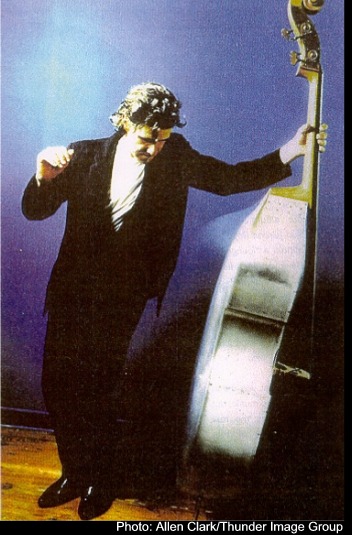
Sideman - Musician Magazine Bassics Magazine Bass Player Crosstalk - Music Connection Bass Notes - Bass Player Magazine Steady Rollin' by Bob Margolin - Blues Review Nightwatch - The Washington Post
Bassics Magazine, Spring 1998
When you think of the Rolling Stones and bass, you first think of Bill Wyman. Then
perhaps, Ronnie Wood. Then Darryl Jones. And then, Jeff Sarli. Jeff Sarli? Who the
heck is Jeff Sarli?
Guitar World quoted Keith Richards: "One idea I had was to use an upright bassist on
three tracks: 'Flip the Switch', 'Too Tight', and on 'How Can I Stop'. I wanted to get away from
the dum, dum dum dum electric bass. I figured, 'let's try to get some swing.'" And so they did.
How did it all come about? Blame it on the producer! Sarli had worked with Rob Fraboni on the
John Mooney's CD, Against the Wall, and Fraboni later invited Sarli to meet Keith Richards in
Connecticut to "do my Willie Dixon thing. I walked in, and Keith was at the piano. I picked up
my bass and just started playing. We hit it off from the get-go." When Fraboni was chosen by
the Rolling Stones to work on their new CD, Bridges to Babylon, Sarli received "the call I've been
dreaming about since I was 14 years old". He was brought to Los Angeles to play on only one song,
and ended up playing upright on three.
"The Stones brought me out to Los Angeles to play on the song 'Too Tight' - a typical Keith
Richards sounding song - which Keith referred to as a song he's been writing for the past 20 years.
Instead of electric, he wanted this Willie Dixon sound… something more syncopated. Whip out your
copy of the song 'Johnny B. Goode' - you'll be surprised by the bass line - Willie's playing a lot
of syncopated stuff, that's what Keith wanted."
Like myself, Sarli is from the two-year plan of music schooling, you know, "live it, learn it,
and move on." It seems so often that we spend two years in a particular musical situation (including
school) and then it really does seem to be time to move on. "It's not that I get bored, it's just
that there's so much out there to learn." he admits.
Born in White Plains, NY in 1958, Sarli was "a pretty dysfunctional kid. I guess a lot of musicians
say that they were loners as kids." His family moved to Annapolis, MD when he was 16 and he started playing
professionally when he was 19, first on guitar, then later on upright bass. "The first time I heard
Charlie Haden, I was captivated by the sound and the look of the bass. From the moment I picked one
up, I never put it down." His first professional gig was with Billy Hancock and the Tennessee Rockets.
"The first year with this band was a nightmare. I hadn't been playing bass for very long, so my fingers
would be bleeding at the end of each gig. It was torture…"
From there, Sarli has performed and/or recorded with blues guitarist Bob Margolin; the Uptown Rhythm
Kings; formed a band with drummer Big Joe - Big Joe and the Dynaflows, blues-rock guitarist Tom Principato,
Too Much Fun led by Commander Cody's original guitarist Bill Kirchen, soul guitar player Robert Ward,
Marshall Crenshaw, and currently performs with John Mooney's trio Bluesiana.
Instrument-wise, Sarli uses "a '50s Kay which I've always played. It's an American-made plywood bass.
In fact, it's actually two basses - the neck came off a Kay I had been playing for years, the body was
pretty worn out. I found another Kay body at a junk shop and I took the neck off of my first one and I
had it attached to the body of this new one. I have an old style of setup - I use two old gut strings.
Then I had the bass sprayed black and red. My bass repairman thinks I'm out my mind… but for some reason
this bass just sounds incredible. The first time worked with producer Rob Fraboni was on John Mooney's
House of Blues album. Later on, Fraboni invited me to meet Keith Richards at Keith's house in Connecticut.
The first words Fraboni said were, 'You're bringing that bass, right?' It's funny 'cause it's just a spray
painted plywood bass - not exactly a fine instrument."
Sarli is into the evolutionary process of both the music and himself: "I don't just remember the chords,
I need to know the vibe, where it's coming from, and its roots, before I can play it. Then I remember it
deep and it becomes part of me - it's just there. I live it and learn it and that's it - you don't have
to worry about it again. I got it!"
-RG
| 
